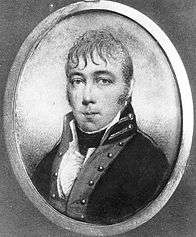USS Retaliation (1798)
| History | |
|---|---|
| Name: | Croyable |
| Builder: | Baltimore, Maryland |
| Launched: | c.1790s |
| Fate: | Captured 7 July 1798 |
| Name: | USS Retaliation |
| Acquired: | by purchase, 30 July 1798 |
| Captured: | 20 November 1798 |
| Name: | Magicienne |
| Acquired: | 20 November 1798 |
| Captured: | 28 June 1799 |
| Name: | USS Retaliation |
| Acquired: | 28 June 1799 by capture |
| Fate: | Sold, 29 November 1799 |
| General characteristics [1] | |
| Tons burthen: | 100 or 107 (bm) |
| Sail plan: | Schooner |
| Complement: |
|
| Armament: |
|
USS Retaliation was the French privateer Croyable, built in Maryland, that then operated out of Santo Domingo. Delaware captured her on 7 July 1798 off New Jersey. She then served in the United States Navy during Quasi-War with France. Two French frigates recaptured her on 20 November 1798. The French Navy took her into service as Magicienne. However, Merrimack captured her on 28 June 1799. She served in the US Navy in the Caribbean briefly, before arriving in Philadelphia in August. She was paid off there and sold on 29 November.
Career
The U.S. warship Delaware, commanded by Capt. Stephen Decatur, Sr., captured the French privateer, Croyable, off Great Egg Harbor Bay, New Jersey, on 7 July 1798. Before her capture, Croyable had been preying upon shipping off the Delaware Capes and had taken a British brigantine and a Philadelphia merchantman, Liberty. She had also boarded and robbed the coaster Alexander Hamilton, whose captain had informed Decatur of Croyable's whereabouts. Decatur brought Croyable to Fort Mifflin in the Delaware River. She was the first American capture of the undeclared war.[2]
The U.S. Navy purchased Croyable on 30 July 1798, manned her at Philadelphia, renamed her Retaliation, and placed her under the command of Lt. William Bainbridge.
Retaliation departed Norfolk on 28 October 1798 with Montezuma and Norfolk and cruised in the West Indies protecting American commerce during the Quasi-War with France. On 20 November, a pair of French frigates, Insurgente and Volontaire, overtook Retaliation while her consorts were away on a chase and forced Bainbridge to surrender the hopelessly out-gunned schooner. However, even as a prisoner, the American officer managed to serve his country. He saved Montezuma and Norfolk by convincing the senior French commander that those American warships were too powerful for his frigates and induced him to abandon the chase.
Renamed Magicienne by the French, the schooner again came into American hands on 28 June 1799, when a broadside from USS Merrimack forced her to haul down her colors. She performed convoy duty in the Caribbean before returning to Philadelphia in August. Her crew was then discharged and the schooner was sold on 29 November 1799 to Thomas and Peter Mackie.
 William Bainbridge Lieutenant, United States Navy, commanded the USS Retaliation in 1798.
William Bainbridge Lieutenant, United States Navy, commanded the USS Retaliation in 1798.
Citations and references
- Citations
- References
- Hamilton, Alexander (1974) The Papers of Alexander Hamilton: April 1797-July 1798. Vol. 21. (Columbia University Press).
- Winfield, Rif & Stephen S Roberts (2015) French Warships in the Age of Sail 1786 - 1861: Design Construction, Careers and Fates. (Seaforth Publishing). ISBN 9781848322042
This article incorporates text from the public domain Dictionary of American Naval Fighting Ships. The entry can be found here.